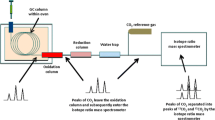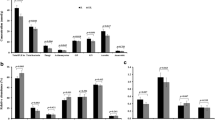Abstract
The cell content of 12 bacterial phospholipid fatty acids (PLFA) was determined in bacteria extracted from soil by homogenization/centrifugation. The bacteria were enumerated using acridine orange direct counts. An average of 1.40×10-17 mol bacterial PLFA cell-1 was found in bacteria extracted from 15 soils covering a wide range of pH and organic matter contents. With this factor, the bacterial biomass based on PLFA analyses of whole soil samples was calculated as 1.0–4.8 mg bacterial C g-1 soil C. The corresponding range based on microscopical counts was 0.3–3.0 mg bacterial C g-1 soil C. The recovery of bacteria from the soils using homogenization/centrifugation was 2.6–16% (mean 8.7%) measured by PLFA analysis, and 12–61% (mean 26%) measured as microscopical counts. The soil content of the PLFA 18:2ω6 was correlated with the ergosterol content (r=0.92), which supports the use of this PLFA as an indicator of fungal biomass. The ratio 18:2ω6 to bacterial PLFA is therefore suggested as an index of the fungal:bacterial biomass ratio in soil. An advantage with the method based on PLFA analyses is that the same technique and even the same sample is used to determine both fungi and bacteria. The fungal:bacterial biomass ratio calculated in this way was positively correlated with the organic matter content of the soils (r=0.94).
Similar content being viewed by others
References
Anderson JPE, Domsch KH (1973) Quantification of bacterial and fungal contributions to soil respiration. Arch Mikrobiol 93:113–127
Bååth E (1992) Thymidine incorporation into macromolecules of bacteria extracted from soil by homogenization-centrifugation. Soil Biol Biochem 24:1157–1165
Bååth E (1994) Thymidine and leucine incorporation in soil bacteria with different cell size. Microb Ecol 27:267–278
Bååth E, Frostegård Å, Fritze H (1992) Soil bacterial biomass, activity, phospholipid fatty acid pattern, and pH tolerance in an area polluted with alkaline dust deposition. Appl Environ Microbiol 58:4026–4031
Balkwill DL, Leach FR, Wilson JT, McNabb JF, White DC (1988) Equivalence of microbial biomass measures based on membrane lipid and cell wall components, adenosine triphosphate, and direct counts in subsurface aquifer sediments. Microb Ecol 16:73–84
Boon PI (1991) Bacterial assemblages in rivers and billabongs of southeastern Australia. Microb Ecol 22:27–52
Bott TL, Kaplan LA (1985) Bacterial biomass, metabolic state, and activity in stream sediments: Relation to environmental variables and multiple assay comparisons. Appl Environ Microbiol 50:508–522
Faegri A, Lid Torsvik V, Goksöyr J (1977) Bacterial and fungal activities in soil: Separation of bacteria and fungi by a rapid fractionated centrifugation technique. Soil Biol Biochem 9:105–112
Federle TW (1986) Microbial distribution in soil—new techniques. In: Megusar F, Gantar M (eds) Perspectives in microbial ecology, Slovene Society for Microbiology, Liubjana, pp 493–498
Frostegård Å, Tunlid A, Bååth E (1991) Microbial biomass measured as total lipid phosphate in soils of different organic content. J Microbiol Methods 14:151–163
Frostegård Å, Bååth E, Tunlid A (1993a) Shifts in the structure of soil microbial communities in limed forests as revealed by phospholipid fatty acid analysis. Soil Biol Biochem 25:723–730
Frostegård Å, Tunlid A, Bååth E (1993b) Phospholipid fatty acid composition, biomass and activity of microbial communities from two soil types experimentally exposed to different heavy metals. Appl Environ Microbiol 59:3605–3617
Gessner MO, Chauvet E (1993) Ergosterol-to-biomass conversion factors for aquatic hyphomycetes. Appl Environ Microbiol 59:502–507
Grant WD, West AW (1986) Measurement of ergosterol, diaminopimelic acid and glucoseamine in soil: Evaluation as indicators of microbial biomass. J Microbiol Methods 6:47–53
Harwood JL, Russel NJ (1984) Lipids in plants and microbes. George Allen & Unwin, London Boston Sydney
Hopkins DW, Macnaughton SJ, O'Donell AG (1991) A dispersion and differential centrifugation technique for representatively sampling microorganisms from soil. Soil Biol Biochem 23:217–225
Ingham ER, Coleman DC (1984) Effects of streptomycin, cycloheximide, fungizone, captan, carbofuran, cygon, and PCNB on soil microorganisms. Microb Ecol 10:345–358
Jantzen E, Kvalheim OM, Hauge TA, Hagen N, Bövre K (1987) Grouping of bacteria by Simca pattern recognition on gas chromatographic lipid data: Patterns among Moraxella and rod-shaped Neisseria. Syst Appl Microbiol 9:142–150
Johns RB, Perry GJ (1977) Lipids of the marine bacterium Flexibacter polymorphus. Arch Microbiol 114:267–271
Kowalenko CG, McKercher RB (1971) Phospholipid P content of Saskatchewan soils. Soil Biol Biochem 3:243–247
Landi L, Badalucco L, Pomare F, Nannipieri P (1993) Effectiveness of antibiotics to distinguish the contributions of fungi and bacteria to net nitrogen mineralization, nitrification and respiration. Soil Biol Biochem 12:1771–1778
Newell SY, Miller JD, Fallon RD (1987) Ergosterol content of saltmarsh fungi: Effect of growth condition and mycelial age. Mycologia 79:688–695
Nordby H, Nemec S, Nagy S (1981) Fatty acids and sterols associated with citrus root mycorrhizae. J Agric Food Chem 29: 396–401
Ratledge C, Wilkinson SG (eds) (1988) Microbial lipids, vol. 1. Academic Press, New York London
Salmanowicz B, Nylund J-E (1988) High performance liquid chromatography determination of ergosterol as a measure of ectomycorrhiza infection in Scots pine. Eur J For Pathol 18:291–298
Schallenberg M, Kalff J, Rasmussen JB (1989) Solutions to problems in enumerating sediment bacteria by direct counts. Appl Environ Microbiol 55:1214–1219
Seitz LM, Sauer DB, Burroughs R, Mohr HE, Hubbard JD (1979) Ergosterol as a measure of fungal growth. Phytopatology 69:1202–1203
Tunlid A, White DC (1992) Biochemical analysis of biomass, community structure, nutritional status, and metabolic activity of microbial communities in soil. Soil Biochem 7:229–262
Tunlid A, Hoitink HAJ, Low C, White DC (1989) Characterization of bacteria that suppress Rhizoctonia damping-off in bark compost media by analysis of fatty acid biomarkers. Appl Environ Microbiol 55:1368–1374
Wardle DA (1992) A comparative assessment of factors which influence microbial biomass carbon and nitrogen levels in soil. Biol Rev 67:321–358
Wellburn AR, Robinson DC, Thomson A, Leith ID (1994) Influence of episodes of summer O3 on Δ5 and Δ9 fatty acids in automnal lipids of Norway spruce [Picea abies (L.) Karst.]. New Phytol 127:355–361
White DC, Davis WM, Nickels JS, King JD, Bobbie RJ (1979) Determination of the sedimentary microbial biomass by extractible lipid phosphate. Oecologia 40:51–62
Zelles L, Bai QY (1994) Fatty acid patterns of phospholipids and lipopolysaccharides in environmental samples. Chemosphere 28:391–411
Author information
Authors and Affiliations
Rights and permissions
About this article
Cite this article
Frostegård, A., Bååth, E. The use of phospholipid fatty acid analysis to estimate bacterial and fungal biomass in soil. Biol Fert Soils 22, 59–65 (1996). https://doi.org/10.1007/BF00384433
Received:
Issue Date:
DOI: https://doi.org/10.1007/BF00384433




